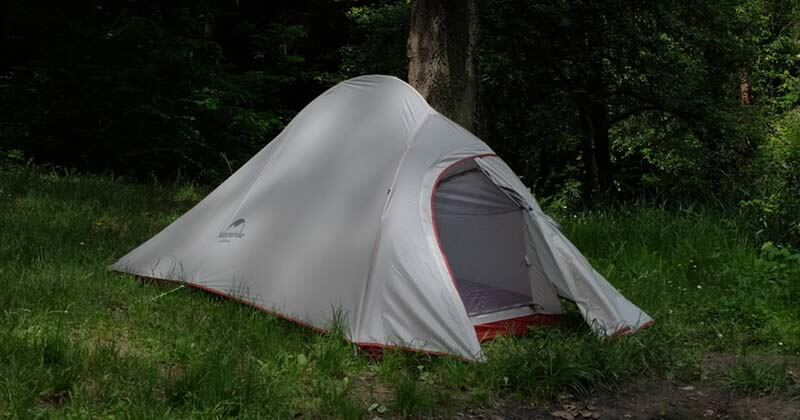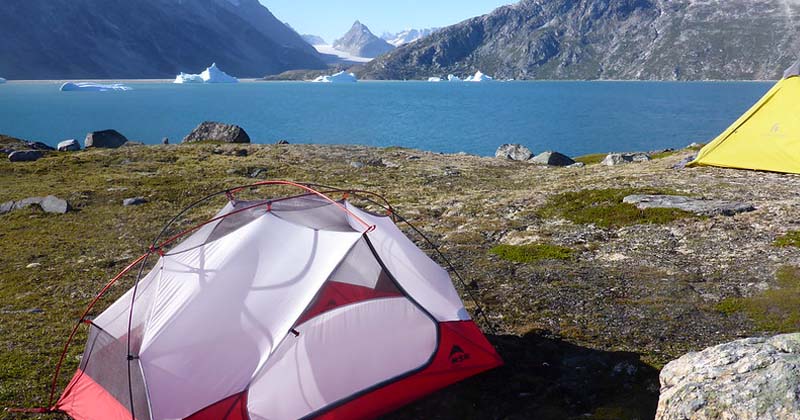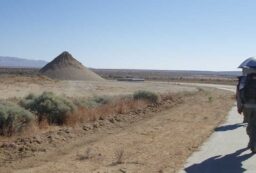Trying to cut weight from your pack so you can enjoy longer backpacking trips? Aside from food and water, your shelter is usually the heaviest thing in your pack. You can save a lot of weight by upgrading to a lightweight tent. But what qualifies as lightweight?
How much does a lightweight tent weigh?
When backpacking solo, a tent under 4lbs is considered lightweight and a tent under 2lbs is considered ultralight. When backpacking with a partner and sharing a tent, calculate weight per person: A tent which weighs less than 2 lbs per person is considered lightweight and a tent less than 1 lb per person is considered ultralight.

For example, I use the Naturehike Cloud Up 2 tent (above) when backpacking with my daughter.
- 1-person version = 3.5 lbs. This barely meets the definition for lightweight.
- 2-person version = 3.75 lbs. When you divide the weight between two people, it truly becomes a lightweight tent at 1.875 lbs per person.
- 3-person version = 4.9 lbs. Or 1.6 lbs per person, which is lightweight.
*Read my review of the Naturehike Cloud Up here or see these top picks for cheap UL backpacking tents.
Remember: When using the “weight per person” method, calculate how many people will be using the tent and NOT how many people the tent says it can hold.
This is because 2-person tents usually can’t hold two people. As a general rule, a two-person tent will fit only fit one person comfortably. A three-person tent will fit two people…
In my case, I’m able to use a 2-person tent when backpacking with my daughter because we are both so small (I’m barely 5’ tall and she’s even tinier). Two tall men would not be able to fit in our same tent.
Tent Weight vs. Size
To make a tent lightweight, manufacturers often cut back on size drastically. As a result, lots of lightweight tents are very cramped. So, if you are a tall person or want a roomier tent, you might want to define lightweight as square feet per ounce.
Below are some examples of tent weight per square foot.
Tent Weight Size Oz. Per Sq. Ft.
35oz 29 sq. ft. 1.2
North Face O2 36oz 25.6 sq. ft. 1.4
40oz 31.7 sq. ft. 1.26
If you just look at the overall weight of the tents, it might seem like the REI tent is the heaviest. However, the REI tent has significantly more floor space. When you calculate the tent weight per floor space, you get a better idea of which tent is really the lightest. Not surprisingly, the lightest tent is also the priciest.
Tent Setup vs. Weight Savings
How is the REI Flash tent so lightweight yet still affordable? It’s because the tent doesn’t have any poles. Instead, you pitch the tent with your trekking poles. This is the ultimate definition of “multipurpose gear” and allows you to save weight while still getting a roomy tent.
There are trade offs though. As I talk about in this post about the best trekking pole tents, it can be a pain in the ass to pitch a tent with trekking poles. Is it really worth saving a bit of weight if it is going to cause you hassle on the trail?
Likewise, are any of the other trade offs which come with lightweight tents — like flimsy material and fewer features — really worth it to save a few ounces? Going lightweight isn’t a competition about who can get the lowest base weight. It’s about making the experience more enjoyable!
The Bottom Line?
There are a few ways of calculating what’s “lightweight” and “ultralight” with tents. Make sure you look at them all so you get a nuanced view of how heavy or light the tent really is.













1 Comment
Karol
July 28, 2022 at 9:12 pmPlease please please use metric system too. I wanted to have a read, but once I saw lbs, oz. and Oz. Per Sq. Ft. I gave up.